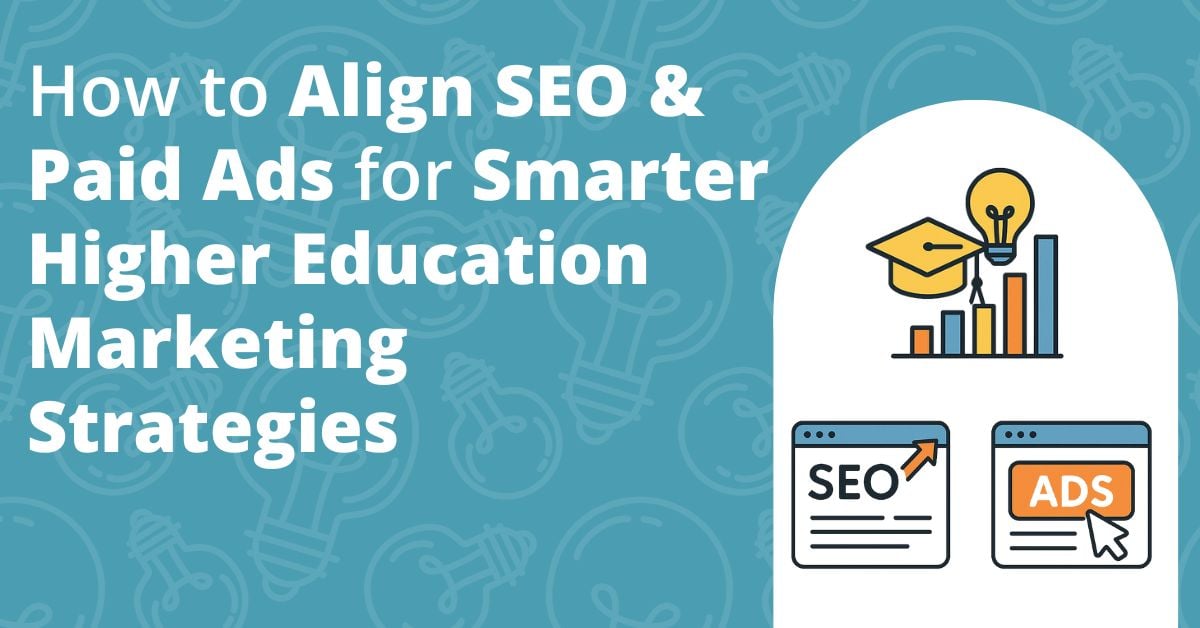Higher Education Marketing Strategies: Align SEO & Paid Ads for Smarter Results
July 24th, 2025 by


Key Insights
- The modern student journey is multi-channel: Your marketing efforts must span search engines, social platforms, and AI tools.
- SEO builds long-term visibility: SEO is a key strategy for sustaining awareness and reducing overall acquisition costs over time.
- Digital ads deliver speed and precision: Paid ad placements boost visibility during critical enrollment windows and for time-sensitive offers.
- Together, SEO and ads drive better results: Aligning both helps you maintain visibility and adapt to changing search behaviors.
Today’s prospective students are intentional researchers in their college search.
They explore degree programs, admissions requirements, and career outcomes on platforms like Google, ChatGPT, TikTok, and YouTube, often before visiting your website. To reach them during these early moments of consideration, your higher education marketing strategies must prioritize visibility across search engines, social platforms, and AI-driven tools.
This is where SEO and digital ads work in tandem to keep your institution present, credible, and competitive.
When aligned well, these tactics guide prospective students from first search to final enrollment with greater efficiency and impact.
Search Engine Optimization (SEO) at a Glance

What is SEO?
SEO stands for search engine optimization. It’s a long-term strategy that improves your website’s visibility in organic (non-paid) search results. This involves refining your content, technical structure, and site authority so your pages appear more prominently when prospective students search on platforms like Google, ChatGPT, and other AI-driven tools.
In higher education, visibility at key points in the decision-making process directly impacts who finds your programs and who doesn’t. SEO helps your institution show up across the enrollment journey, from early awareness to application. When your site is optimized effectively, it becomes easier for students to find the information they need and easier for you to convert interest into action.
Why is SEO important for higher education institutions?
SEO is important for higher education institutions because it helps your programs appear where student intent begins. Research shows that 68% of online experiences start with a search engine, making visibility in those early interactions critical for attracting qualified prospects.
Today’s students are self-directed and often explore degree options, admissions requirements, and tuition costs on their own, sometimes weeks or months before they ever reach out to an academic institution. If your content doesn’t surface during that initial research phase, your school may never make the shortlist.
By investing in SEO, higher ed institutions build lasting authority, credibility, and trust. It reinforces your brand presence without relying entirely on paid channels and sets the foundation for long-term enrollment growth.
What are the benefits of higher education SEO?
A strong SEO strategy does more than drive traffic. It brings the right traffic. In aligning your content with what prospective students search, you improve visibility and engagement at every stage of the recruitment pipeline.
Some of the leading benefits of higher education SEO include:
- Capturing high-intent search traffic from students actively searching for programs like yours
- Supporting content marketing by making blogs, guides, and admission web pages more discoverable
- Improving user experience through technical SEO that enhances site speed and mobile responsiveness
- Boosting credibility with higher rankings, rich snippets, and inclusion in AI Overviews and other AI-powered search features
- Enabling smarter decisions through keyword research and user behavior analytics
- Strengthening long-term visibility as ad costs rise and search algorithms evolve
SEO is not just a marketing add-on. It’s a strategic asset that improves performance across digital channels. When done well, it strengthens your institution’s credibility and reaches students where they’re actively searching.
What does higher education SEO entail?
Higher education SEO requires a strategic approach that reflects how 1) students search and 2) how modern search engines and AI platforms process content. It focuses on clarity, structure, and alignment with user intent.
Key elements of a higher education SEO strategy include:
- Conducting keyword research based on student goals, questions, and decision-making stages
- Using entity-based and semantic SEO to match how AI systems interpret and connect information
- Optimizing on-page elements like meta tags, headers, and image alt text
- Creating evergreen content such as program pages, tuition details, and frequently asked questions
- Improving technical performance through mobile-friendly design, fast load times, and structured data
- Strengthening internal linking and earning high-quality citations from trusted sources
- Monitoring performance metrics and adjusting tactics to respond to algorithm changes and user behavior
This ongoing work creates a structured foundation that helps your institution remain relevant across traditional and AI-driven search platforms.
Digital Advertising (Paid Ads/Pay-Per-Click) at a Glance

What are digital paid ads/PPC?
Digital paid advertising refers to any online campaign where you pay to promote your content, programs, or brand across platforms where prospective students spend time. These ads can appear in search results, on social media feeds, within videos, or across websites through display networks.
PPC, or pay-per-click, is one of the most common payment models used in digital advertising. Instead of paying for impressions, you’re charged only when someone clicks your ad. In this way, paid advertising describes the strategy, while PPC refers to how you’re billed.
Common platforms include Google Ads for search and display, Meta (Facebook and Instagram) for interest-based targeting, YouTube for video promotion, and programmatic networks for broader reach. Each offers a different way to connect with prospective students based on their behaviors, demographics, and intent.
Why should digital advertising be part of your higher ed marketing strategy?
Digital advertising is a vital tool for reaching students during critical decision-making windows. Unlike organic strategies, which take time to gain traction, paid ads offer “immediate” visibility in high-traffic environments like search results and social feeds. This immediacy is especially valuable during application pushes, event promotions, or when organic rankings fluctuate.
For colleges and universities competing for attention in crowded markets, digital ads offer the agility to respond to shifting trends and student behavior in real time. They also create a clear path to visibility when SEO alone can’t secure top placement, especially for high-volume, high-competition keywords.
When time-sensitive goals are at stake, paid ads allow you to act quickly, focus your message, and precisely reach your target audience.
What are the benefits of digital ads?
Digital ads offer a level of control, speed, and insight that is difficult to achieve through other channels. With the right setup, you can run targeted campaigns that respond to real-time behavior and performance data.
Benefits of digital ads include:
- Fast results, bringing qualified traffic to your site shortly after a campaign launches
- Trackable performance that allows you to connect ad spend to inquiries and applications
- Targeting precision based on factors like location, age, device, interests, or behavior
- Budget efficiency through dynamic allocation based on campaign performance
- Seasonal flexibility to scale campaigns up or down as enrollment cycles shift
- Campaign testing to compare messages, creative formats, and calls to action
- Retargeting power to re-engage visitors who left your site without taking the next step
Well-executed campaigns go beyond visibility gains. They deliver measurable insight into which messages and channels are driving potential students to act.
What does a digital advertising strategy entail?
A strong digital advertising strategy involves setting clear goals, targeting a well-defined audience, and choosing ideal platforms for delivery. This helps your institution stay adaptable while reaching students where they spend their time online.
Key elements of a digital advertising strategy include:
- Identifying high-intent keywords and audience segments by program, location, age, and behavior
- Choosing platforms that align with campaign goals, such as Google, YouTube, Meta, LinkedIn, or display networks
- Writing ad copy, headlines, and landing pages tailored to each platform and audience
- Designing creative assets that reflect your brand and support campaign objectives
- Setting budgets, bids, and targeting rules by geography, demographics, or device
- Launching campaigns with tracking to measure clicks, inquiries, and conversions
- Adjusting creative, targeting, and spend based on performance
- Retargeting visitors who viewed your site but didn’t convert
This coordinated approach helps higher ed marketers reach the right students at the right time while maintaining full visibility into campaign success.
Why SEO and Digital Paid Ads Work Better Together


When used together, SEO and digital ads give you better control over how and when students discover your programs. They serve different purposes but share the same goal: helping your institution show up, build trust, and guide prospective students toward taking the next step.
Maximize visibility in search results
Running both SEO and paid search campaigns lets your institution appear in multiple positions on a single results page. This increases your visibility, reinforces brand credibility, and reduces the likelihood of competitors taking that spot instead.
Drive traffic while SEO gains traction
SEO is a long-term, yet sustainable, investment. Paid ads help you stay visible in the meantime, especially when launching a new program or entering a competitive market. While your organic rankings build, ads keep inquiries flowing.
Test messaging before you commit
Digital ads allow you to quickly test headlines, descriptions, and offers. The best-performing messages can then be applied to SEO page titles, meta descriptions, and even on-page content, improving both click-through rates and relevance.
Validate keywords with real results
Paid search shows you which keywords actually drive clicks and conversions. This data can guide your SEO strategy by helping you focus on the terms students search most often and respond to rather than relying solely on keyword tools.
Retarget prospects who leave
SEO may attract the initial visit, but not every student is ready to apply right away. With paid ads, you can retarget those visitors and keep your institution top of mind, especially during high-stakes decision windows.
Lower CPC with better landing pages
SEO principles like clear structure, fast load times, and relevant content can improve your ad landing pages. This often leads to higher Quality Scores in Google Ads, which reduces your cost-per-click and increases return on ad spend.
Share data to make smarter decisions
When SEO and paid ad teams work together, both channels benefit. Search terms, audience behavior, and performance metrics from one can shape strategy for the other, leading to stronger messaging, better targeting, and higher conversion rates.
How to Align Your Strategy and Budget with Goals
A thoughtful, comprehensive marketing plan considers how SEO and paid ads contribute at different points in the recruitment cycle. While both digital marketing strategies play a unique role, aligning your investment with your institutional goals (rather than dividing tactics by default) helps you make more strategic, data-informed decisions.
Use SEO for:
Building visibility for evergreen content
Program pages, admissions FAQs, and degree outcomes are high-interest assets that students search for year-round. SEO ensures these pages consistently rank and remain discoverable across enrollment cycles.
Answering long-tail, high-intent questions
Students often search with specific phrases like “best online MPH programs for working adults.” Optimizing for these longer queries helps your content meet students at key decision-making moments.
Strengthening authority over time
Search engines and AI platforms reward content that demonstrates expertise and trust. By publishing helpful, on-topic SEO content regularly — and earning backlinks and citations from reputable sources — you signal authority over time and improve your chances of ranking across high-impact search terms.
Supporting decision-making after inquiry
SEO helps prospective and admitted students find the content they need after expressing interest, such as financial aid resources, enrollment steps, and orientation details. Optimizing this type of content ensures your institution remains visible and helpful beyond the initial click.
Reducing long-term CPI
Unlike paid ads, organic traffic doesn’t require a cost per click. A strong SEO foundation lowers dependency on paid placements over time, driving qualified leads while keeping cost per inquiry (CPI) in check.
Use digital ads for:
Accelerating time-sensitive goals
Campaigns tied to deadlines, events, or scholarships need instant visibility to drive action. Paid ads allow you to deliver focused, high-priority messages exactly when timing matters most.
Launching new programs or locations
New academic offerings or secondary campuses often lack the organic search authority to rank well early on. Paid ads help you build awareness and attract early interest while SEO efforts gradually take hold.
Competing on high-volume search terms
For highly competitive keywords where top rankings are difficult to secure, paid ads keep your institution visible. This ensures you’re not missing out on critical traffic during peak search activity.
Testing and refining your message
Digital campaigns offer a fast, low-risk way to test headlines, offers, and positioning statements. Use this performance data to gain insights, inform future updates, and shape messaging across other channels.
Reaching segmented or niche audiences
With detailed targeting options, paid ads let you focus on specific groups, like adult learners, out-of-state students, or those interested in a particular program. This helps extend your reach beyond what organic search alone can deliver.
Questions to help allocate budget
Before deciding how much to invest in SEO or digital ads, it’s important to clarify the goals, timeline, and audience of each initiative. Use the following questions to guide a smarter, more intentional allocation of resources:
- Is this a short-term campaign or a long-term visibility play?
- Do you already rank organically for target keywords, or are you starting from scratch?
- Are you trying to increase awareness, generate inquiries, or drive completed applications?
- What is the lifetime value of the program or student audience you’re targeting?
- Do you need geographic or behavioral targeting that SEO alone can’t deliver effectively?
- What insights from past campaigns can inform your channel mix for this initiative?
Think of SEO as the groundwork for sustained visibility and trust, while paid campaigns offer speed and flexibility. By evaluating timing, audience intent, and program priorities, you can allocate budget where it makes the most impact.
Create a Stronger Higher Education Marketing Strategy
The most effective higher education marketing strategies don’t rely on a single channel. They align tactics to meet student expectations at every stage of their search journey.
By pairing long-term organic visibility through SEO with the immediacy and precision of digital advertising, your institution will reach more prospective students, guide them through complex decisions, and support better outcomes from first search to final enrollment.
If you’re looking for a more intentional way to prioritize your marketing efforts and budget, we’d be honored to help. Download “Solve Your Higher Ed Marketing Puzzle With SEO and Paid Digital Ads” to learn how to:
See how you can integrate SEO and paid advertising to power your enrollment pipeline today.

